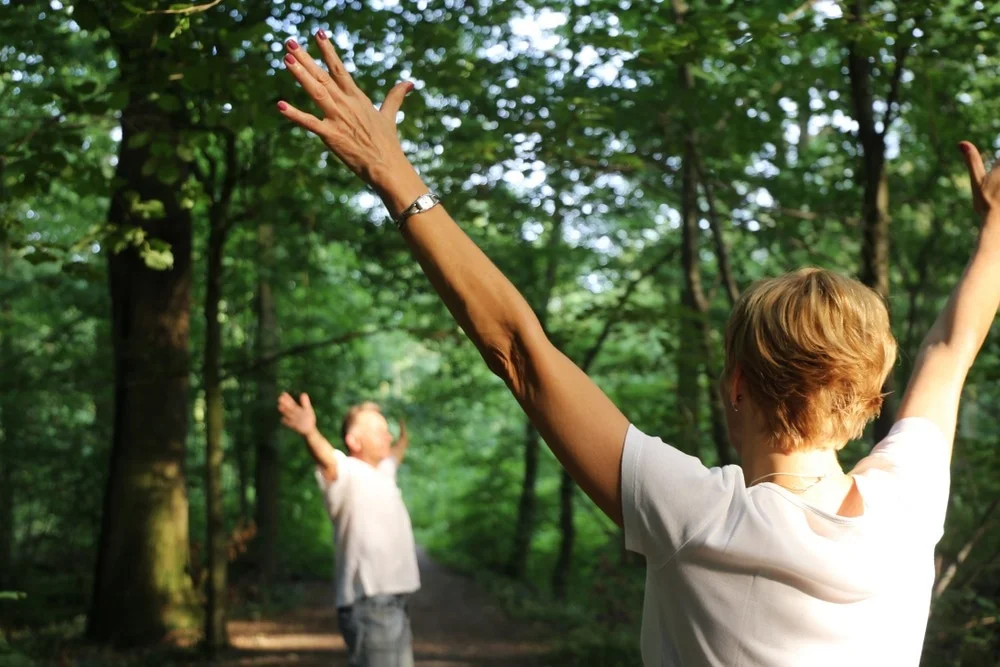Have you ever experienced a profound sense of peace and rejuvenation after being in nature? In today’s fast-paced, digital-centric world, mental health challenges are more prevalent than ever, pushing many to seek refuge in the healing embrace of the natural world.
While many therapies exist, promising relief and recovery, a significant number of individuals yearn for something more— a deeper, more organic connection that can foster true healing.
Enter the realm of forest therapy, a practice grounded in scientific research and ancient wisdom, offering a promising avenue for enhancing mental health and well-being.
This unique form of therapy doesn’t just offer an escape from the hustle and bustle of daily life; it provides a profound connection to the natural world, which has been shown to have tangible benefits for mental health recovery.
Let’s explore the mechanisms through which forest therapy aids mental health recovery, shedding light on its benefits and offering practical ways to weave this therapeutic practice into the fabric of our lives.
Understanding Forest Therapy

Forest therapy, often encapsulated in the Japanese practice of shinrin-yoku, which translates to “forest bathing,” represents a profound reconnection of humans with the natural environment through a mindful immersion in forests and natural spaces.
This practice, which emerged in Japan during the 1980s as a response to the technological overload and stress of urban life, emphasizes the therapeutic aspect of being in nature.
It is grounded in the intuitive belief that spending time in forests can heal our bodies and minds, a concept now increasingly supported by scientific research.
The principles behind forest therapy are simple yet deeply transformative. They revolve around human well-being being intricately connected to our relationship with the natural world.
By engaging our senses—sight, hearing, taste, smell, and touch—while walking slowly and reflectively in nature, we open ourselves to the healing power of the environment.
This practice is about physical exercise and experiencing the forest atmosphere, fostering a sense of peace, rejuvenation, and a deeper connection to the planet and its cycles.
Incorporating elements like a living tree memorial into forest therapy sessions can enhance the experience, providing a tangible connection to the cycle of life and the enduring nature of our relationship with the earth.
These memorials serve as a reminder of life’s continuity, grounding individuals in the present moment while offering a unique way to honor loved ones in a natural setting.
Through forest therapy, participants are invited to slow down and recalibrate their senses, finding balance and health in embracing the natural world.
The Science of Nature’s Healing Effects
The profound impact of nature on our well-being is both a psychological and physiological phenomenon underpinned by a growing body of scientific research.
Studies have consistently demonstrated that spending time in natural environments can significantly improve mood and reduce stress levels.
For instance, forest walks have been shown to decrease cortisol, a stress hormone, more effectively than urban walks.
This natural setting soothes the mind and enhances cognitive function, including memory and attention span, by providing a restorative environment free from overstimulating urban landscapes.
At the heart of our affinity for the natural world lies biophilia, a term popularized by biologist E.O. Wilson to describe the innate human inclination to connect with nature and living organisms.
This evolutionary bond speaks to our deep-seated need to be in harmony with the earth, suggesting that our mental health is intricately linked to our relationship with the natural environment.
Biophilia explains why even small elements of nature, such as houseplants or a view of a garden, can uplift our psychological state, underscoring the importance of integrating natural elements into our daily lives for mental wellness.
Through the lens of biophilia and supported by empirical evidence, it becomes clear that the healing power of nature is a fundamental aspect of human health, offering a path to mental recovery and balance.
The science behind nature’s healing effects illuminates the pathway towards harnessing these benefits, advocating for a lifestyle that embraces the outdoors as a source of healing and rejuvenation.
Nature’s Impact on Mental Health Recovery
Forest therapy, an immersive experience in the natural world, has emerged as a powerful ally in the battle against mental health challenges like depression, anxiety, and stress-related disorders.
This therapeutic practice, deeply rooted in the essence of nature, offers more than just a tranquil retreat from the chaos of daily life; it provides a scientifically-backed pathway to mental health recovery.
Studies have consistently shown that spending time in forests and green spaces can significantly reduce symptoms of depression and anxiety, lower stress levels, and improve mood.
The serene environment, the soothing sounds, and the fresh, clean air work together to create a healing setting that nurtures the mind and body.
The research goes deeper into the physiological effects of nature on the human brain, revealing that exposure to natural environments can lead to changes in brain activity, particularly in regions linked to emotion regulation, stress reduction, and attention restoration.
For instance, neuroimaging studies have found that walks in the forest are associated with decreased activity in the prefrontal cortex, an area of the brain involved in rumination — repetitive thoughts focused on negative emotions.
This reduction in neural activity corresponds with a decrease in negative emotions, suggesting that forest therapy can help interrupt the cycle of negative thoughts that often characterize mental health disorders.
By fostering a direct, physical connection with the natural world, forest therapy offers a unique and effective approach to mental health recovery.
It encourages individuals to engage all their senses, allowing the therapeutic qualities of nature to envelop them, facilitating a profound psychological shift towards healing and well-being.
This holistic approach not only aids in immediate stress relief but also contributes to long-term mental health resilience, making forest therapy a valuable component of comprehensive mental health recovery strategies.
Practical Applications of Forest Therapy
Forest therapy doesn’t require vast wilderness or remote forests; it’s about finding and connecting with nature wherever you are.
For those living in urban environments, engaging with nature can be as simple as visiting local parks, tending to a garden, or even spending time with indoor plants. These activities offer a bridge to the natural world, fostering a sense of calm and grounding.
It’s about mindfulness and presence—taking the time to observe a leaf’s intricacies, bark’s texture, or the dance of light and shadow through the trees. Such moments of connection can significantly reduce stress and improve mental clarity.
For a more structured approach to forest therapy, guided sessions can be incredibly beneficial. Certified forest therapy guides facilitate immersive experiences, helping participants deepen their connection to the natural environment through sensory engagement and mindful practices.
To find a certified guide, one can start by visiting the websites of professional organizations dedicated to forest therapy.
These platforms often provide directories of trained guides and information on how to participate in guided walks, designed to enhance physical, mental, and emotional well-being.
Incorporating forest therapy into one’s life, whether independently in local green spaces or through guided sessions, offers a powerful tool for mental health recovery and maintenance.
It’s an invitation to slow down, reconnect with the natural world, and find peace in the beauty surrounding us, even in the city’s heart.
Incorporating Forest Therapy into Daily Life

Incorporating the principles of forest therapy into daily life offers a practical and accessible means to enhance mental health, even for those who find themselves in urban environments or with limited access to sprawling natural spaces.
The essence of forest therapy is not just in the vast wilderness but in the mindful connection with nature, which can be cultivated in various settings.
Start by creating small nature sanctuaries at home, such as indoor plants or a dedicated space for meditation surrounded by elements of nature like rocks, wood, and water features. These mini green spaces can be a daily reminder of the natural world’s calming presence.
For urban dwellers, seek out local parks, community gardens, or tree-lined streets for regular walks. Even a brief lunchtime stroll under the canopy of city trees can offer a moment of respite and connection to nature.
The key is consistency; integrating short, frequent interactions with nature into your routine can contribute to your mental health recovery and maintenance.
Additionally, plan regular visits to more extensive natural reserves or parks in your area, allowing for deeper immersion in the therapeutic effects of forest therapy.
Emphasizing the importance of this regular engagement with nature underscores its role as a temporary escape and a fundamental component of mental wellness.
By weaving these moments of natural connection into the fabric of daily life, individuals can foster a sustained sense of peace, balance, and recovery, leveraging the healing power of nature as a steadfast ally in their mental health journey.
Conclusion
As we conclude our exploration of forest therapy and its profound impact on mental health recovery, it’s essential to recognize the solid foundation of scientific evidence supporting this natural healing method.
The connection between our well-being and the serenity of nature is not merely anecdotal; it’s deeply rooted in research that highlights the myriad ways nature contributes to our psychological and emotional healing.
The ability of forest environments to reduce stress, enhance mood, and even improve cognitive function underscores the importance of integrating nature into our healing processes.
Encouraging the incorporation of forest therapy into the journey towards mental wellness is more than a suggestion—it’s a call to action for anyone seeking a sustainable and effective approach to combat the challenges of mental health conditions.
Its accessibility, allowing for diverse and flexible engagement, ensures that nature’s healing power is within reach regardless of location.
Whether through organized forest therapy sessions or solitary walks in local parks, the opportunity to harness nature’s restorative potential is available to all.
Armed with the knowledge of how nature nurtures our minds, we’re invited to step into the forest and onto a path of healing and renewal. Let the natural world be your sanctuary, where recovery and peace go hand in hand.
Embrace the journey through the woods, for it is not just a walk in the park but a stride towards mental wellness.
This connection with nature is a retreat from the modern world and a return to our innate need for the natural environment—a powerful ally in our quest for mental health recovery and overall well-being.

Jean Smith is a fitness enthusiast and blogger who focuses on fitness and a healthy lifestyle. She is passionate about assisting people in living healthier lifestyles and is constantly on the lookout for new and creative methods to stay fit and healthy. Her articles are excellent resources for anyone interested in improving their health and fitness.
